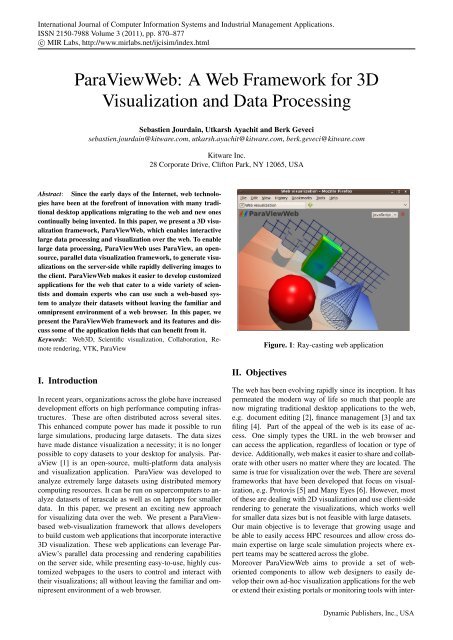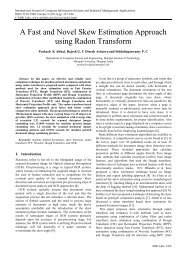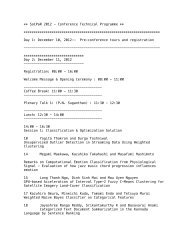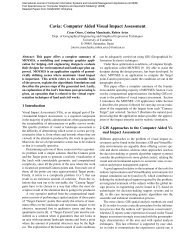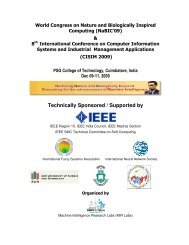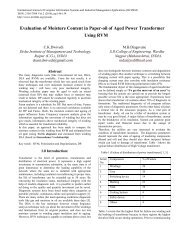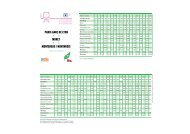ParaViewWeb: A Web Framework for 3D Visualization ... - MIR Labs
ParaViewWeb: A Web Framework for 3D Visualization ... - MIR Labs
ParaViewWeb: A Web Framework for 3D Visualization ... - MIR Labs
Create successful ePaper yourself
Turn your PDF publications into a flip-book with our unique Google optimized e-Paper software.
871 Jourdain, Utkarsh and Geveciactive <strong>3D</strong> data analysis capabilities. The Figure 1 illustratesa simple <strong>3D</strong> web application that use the ray-tracer renderingengine of ParaView through the <strong>ParaView<strong>Web</strong></strong> framework.The rest of this paper is organized as follows. In the Section3, we give a general overview of the system and the differentcomponents involved. Section 4 covers the different componentsof the framework in detail, while in Section 5 we willdemonstrate the use of the framework in different applications.III. Architecture OverviewTo address the need <strong>for</strong> visualizing large datasets in <strong>3D</strong>, wehave developed a framework based on ParaView. We canleverage all of ParaView’s visualization and data processingfeatures such as parallel processing and rendering, volumerendering and ray-casting. To provide interactive <strong>3D</strong> contentin real time to the client, we use server-side rendering.This approach makes it possible to render large geometrieswithout putting any requirement on the client’s devices andenables the use of mobile devices such as iPhone and iPad.To manage the <strong>3D</strong> rendered content on the client side, theframework provides a set of components <strong>for</strong> viewing it inan interactive manner. Those components are available inJava [7], Flash [8] and JavaScript [10] and can be used torotate, zoom or pan the <strong>3D</strong> data.As a framework, <strong>ParaView<strong>Web</strong></strong> uses proven technologies andstandards such as Java Servlet, Java Server Pages (JSP) [12],Java Messaging Service (JMS) [11], and Java PersistenceAPI (JPA) [13] on the server side to do most of the bindingbetween the browser and the ParaView framework. We useJavaScript and JSON-RPC [14] <strong>for</strong> communication protocolon the client side. Being a web-based application, all communicationfollows either HTTP or HTTPS protocols whichmake it easier to manage firewall and proxy issues. <strong>ParaView<strong>Web</strong></strong>provides a collection of components that can beused directly or easily integrated into an existing web portals.These components range from server side to client side.Figure 2 gives an overview of the complete system.On the server side, the visualization server (PWServer) is aParaView-based engine that does the actual visualization eitherby itself or by connecting to a remote ParaView serverrunning over a cluster with MPI. Then, the web service componentnamed PWService manages communication betweenremote visualization servers (PWServer) and clients. It alsoincludes administration webpages, allowing a user to monitorrunning visualization session as well as browsing logsand in<strong>for</strong>mation of the previous ones. On the client side, aJavaScript library is provided <strong>for</strong> creating remote visualizationsand managing them. It also contains several visualizationcomponents enabling users to look at <strong>3D</strong> content in thebrowser interactively.Using these components, developers can build websites orweb portals with visualization and data processing capabilities.These components can be easily integrated intoRich Internet Applications (RIAs) developed using popularweb design infrastructures including qooxdoo [15], Dojo [9],Google <strong>Web</strong> Toolkit [16], jQuery [17], Flex [8], and Java [7].Figure 2 gives a schematic of the various components involved.Our implementation requires any supporting Javabased<strong>Web</strong> Application server, such as Apache Tomcat, anFigure. 2:SystemClient ApplicationsJavaScript Java FlashPWServiceHTTP<strong>Web</strong> ServerTCPJMS BrokerTCP<strong>Visualization</strong> Nodes<strong>Web</strong> ApplicationsPWServer PWServer PWServerPWServerPWServerPWServerMPISchematic of the <strong>ParaView<strong>Web</strong></strong> <strong>Visualization</strong>open-source, freely available implementation.In the next section we will see each of these components indetail.IV. ComponentsAs described earlier, there are 3 major components in the<strong>ParaView<strong>Web</strong></strong> architecture.• <strong>Web</strong> Service provides the facade exposed to the externalnetwork including the web browsers. It enables accessingvisualization as a service over the network.• JavaScript <strong>Visualization</strong> API is used by web-browser tocreate and update visualization pipelines. Internally, ituses the services provided by the <strong>Web</strong> Service to per<strong>for</strong>mthe requested tasks.• <strong>Visualization</strong> Engine is a ParaView application that runson the visualization nodes to do the actual data analysisand processing.A. <strong>Web</strong> ServiceThe crux of a typical web framework is its collection of webservices. The web services provide the facade that is accessibleby the client applications including the webpagesloaded in web browsers. The collection of services providedby <strong>ParaView<strong>Web</strong></strong> framework are called PWService.PWService is a web application that is deployed on the webserver accessed using a particular URL that is determinedat configuration time. Using JSON-RPC [14], which is asimple JSON [18] (JavaScript Object Notation) based protocol<strong>for</strong> remote procedure calls, clients can make calls on
<strong>ParaView<strong>Web</strong></strong>: A <strong>Web</strong> <strong>Framework</strong> <strong>for</strong> <strong>3D</strong> <strong>Visualization</strong> and Data Processing872PWService to start new instances of PWServer, monitor runningPWServer instances, and even send JSON messagesto PWServer. The messages sent to PWServer range fromthose constructing the visualization pipeline to those thatcommunicate the mouse interactions. PWService is responsible<strong>for</strong> delivering responses from the visualization engine(PWServer) to the web clients.The PWService also makes it possible <strong>for</strong> the clients to requestrendered images from the PWServer. To address theconcerns of highly secure domains, we do not expose anyadditional ports through which the clients can communicatewith the PWServer. Hence, their only access is viathe PWService. This provides an interesting challenge especiallywhen providing rendered images as the latency becomescritical. Any overhead inherent in the web service orthe HTTP protocol itself can adversely affect the perceivedframerate on the client side. HTTP protocol [19] in itselfdoes not support the server sending data to the client, unlessthe client requested it. This implies that the client hasto periodically check with the server if a new rendered imageis available and then fetch it. Also every time there arenew requests, a handshake as per the protocol ensues, whichcan affect the latency. To address these issues a few techniquesare gaining widespread acceptance in the communityunder the umbrella term of server push [20] techniques. Eachof rendering components uses a different technique to getthe best per<strong>for</strong>mance. The long-polling [21] (<strong>for</strong> JavaScriptrendering) and streaming (<strong>for</strong> Java rendering) techniquesare the two mechanisms currently implemented inside <strong>ParaView<strong>Web</strong></strong>.<strong>ParaView<strong>Web</strong></strong> uses Abodes BlazeDS [22] remotingtechnology <strong>for</strong> the Flash renderer which also employessimilar techniques under the covers. Next we’ll see the techniquesemployed by each of the renderers implementation.Image in the web pageClient computerupdateImage()updateImage()updateImage()JavaScriptrendererCommunicationover HTTPloadImage(1)loadImage(2)loadImage(3)loadImage(4)<strong>Web</strong>Server (Tomcat)Same networkconnectionThe connectionis still alivePWService(Java)imagereceivedimagereceivedFigure. 3: Image delivery with the long-polling technique<strong>for</strong> JavaScript renderer1) Image delivery <strong>for</strong> JavaScript rendererThe standard polling technique allows the client to fetchserver data periodically with some overhead and latency. Inorder to reduce that latency and to allow JavaScript clientsto fetch binary content such as images, we implemented along-polling communication style, which is also known asComet programming [23]. Instead of using this technique <strong>for</strong>small payload messages, we used it <strong>for</strong> image delivery in theJavaScript renderer. Figure 3 illustrates the communicationbetween the JavaScript renderer of <strong>ParaView<strong>Web</strong></strong> through theweb service and the ParaView rendering engine.Moreover, that technique has an interesting side effect <strong>for</strong>heterogeneous clients: the image delivery is driven by eachindividual client. There<strong>for</strong>e, the <strong>ParaView<strong>Web</strong></strong> service hasbeen designed to deliver only the latest image available tothe client and keep the connection open if nothing new isavailable since the last data transfer. In this manner, eachclient gets the best possible framerate without affecting otherclients. For example, if the server is able to produce 80frames per second <strong>for</strong> a given visualization, some clients mayget only 30 frames per second compared to others who wouldreceive 60 frames per second.2) Image delivery <strong>for</strong> Java Applet rendererJava Applet [7] is not the most supported plat<strong>for</strong>m on theweb but compared to JavaScript or Flash, it provides moreadvanced capability. In order to provide the most efficient environment<strong>for</strong> user interactivity, we developed a renderer <strong>for</strong><strong>ParaView<strong>Web</strong></strong> written in Java that could be used as an embeddedapplet inside a webpage or any other standard Java application.In order to improve the communication between thiscomponent and the server side we used the multi-threadingcapability of the environment to better separate the imagemanagement from the user interaction. Moreover, as Java hassome built-in tools <strong>for</strong> stream management, we used customprotocol on top of the HTTP one. For the mouse interaction,the web service allows the clients to use an up-stream persistentnetwork connection where interaction events are writtenusing an XML structure. This allows any client to use a singleup-stream channel <strong>for</strong> the user interaction and by doingso prevents the client from creating new connections whilethe user is interacting. For the image stream, the web serviceis producing a single zip stream where the images are pushedone after the other as a separate entry in the stream. Using azip stream is also another standard way to communicate witha client a stack of binary content. This allows any other heavyclient to benefit from that existing communication channel.The up-stream channel is only established at the beginning ofthe user interaction and gets released when the user stop itsinteraction. Conversely, the down-stream connection stayslive <strong>for</strong> the entire session.By using a separate up-stream and down-stream communicationchannel we almost mimic a standard socket communication.But even with that communication capability, if wedo not provide any extra care in the image management, wecould get a poor interactivity result with that design. In fact,if all the images produced on the server side are sent throughthe web, we might simply overflow the bandwidth and inducean increasing lag between the current user interaction and theimage that is currently rendered locally. So depending on the
873 Jourdain, Utkarsh and Gevecinetwork capability of the client connection, if we do not dropimages we will create an increasing image stack that will stillbe playing after the user has stopped its interaction. There<strong>for</strong>e,in the same way as we did <strong>for</strong> the image delivery <strong>for</strong> theJavaScript client, we allow the service to skip images on theserver side. As the client and the server remain connectedall the time, it is unnecessary to write all the images on thecommunication socket. There<strong>for</strong>e what we are doing is onlywriting or waiting <strong>for</strong> the latest image available after eachimage has been fully written on the stream. That techniqueprevents this buffering lag and reduces the bandwidth usage.3) Image delivery <strong>for</strong> Flash/Flex rendererFlash [8] is a commonly used technology on the web to deliverrich and interactive content. It was the first choice <strong>for</strong><strong>ParaView<strong>Web</strong></strong> <strong>for</strong> its rendering component since all the infrastructureexisted and is widely used. BlazeDS [22] isthe technology developed by Adobe [24] to support asynchronousmessages between client and server communicationand specifically in a server push [20] paradigm. Basedon those technologies the <strong>ParaView<strong>Web</strong></strong> Flash renderingcomponent has been designed to exchange both mouse interactionsand server images. Un<strong>for</strong>tunately, we did not implementany image dropping technique along the image deliverychain which induces some lag with low connection bandwidthduring interaction.4) Future Extensions<strong>Web</strong> standards are rapidly evolving and new ones will becomeavailable with the new HTML 5 [25] standards. <strong>ParaView<strong>Web</strong></strong>could benefit from several of these either <strong>for</strong> imagedelivery or client side rendering. The communicationmechanism in the JavaScript layer could be even more efficientthan the current Java one by using <strong>Web</strong>Socket [26].On the other hand, <strong>Web</strong>GL [26] could allow the browser todirectly render small geometry models without heavy communicationpayload.Those standards are making their way into the current webbrowsers and some early implementations are available inadvanced browser such as Chrome or Safari. Some experimentationhas been done using those new standards [26] torender a <strong>3D</strong> scene that has been generated by ParaView into aweb browser using the <strong>Web</strong>GL framework. This work couldeasily be used to extend <strong>ParaView<strong>Web</strong></strong> to support such clientsiderendering mechanisms.B. <strong>Visualization</strong> EngineThe actual data analysis and visualization in the <strong>ParaView<strong>Web</strong></strong>framework is done by the visualization engine,called PWServer. PWServer is a ParaView-based processthat can be thought of as a headless ParaView applicationthat responds to the JSON messages relayed via the PWService.In typical configurations, the web-server and the visualizationsnodes are separate machines. This means that thePWService has to use network communication to relay themessages to PWServer. In our design, we use Java MessageService (JMS) <strong>for</strong> this communication. JMS is an API <strong>for</strong>sending messages between two or more clients which wasproposed as part of the Java Plat<strong>for</strong>m. There are severalproprietary as well as open source implementations available<strong>for</strong> the both the relaying server (known as the JMS Broker)as well as the message sending and receiving libraries. Theprotocol employed is still JSON-RPC-based even though thecommunication is over JMS.PWServer is the visualization engine. It can be set up to useMPI to per<strong>for</strong>m parallel data processing and rendering over acluster or as a single process and it does all the data processingand rendering. For each separate visualization session,we created a separate PWServer process. PWService handlesthe management of these instances of PWServer, whetherthey are local or working on a remote cluster and involvingMPI internal communication.To ensure that the client application perceives the best possibleframerate when interacting, the PWServer employs acouple of optimizations.1) Asynchronous ProcessingAs most users would expect in remote rendering, every userinteraction that affects the <strong>3D</strong> scene should trigger the renderingof an image which should be immediately shipped tothe clients. However, there undoubtedly is some delay betweenthe client requesting an image and the server deliveringone. If the server continuously processes the requestsreceived from the client while the user interacts, the user isbound to see a lag in the movement. To overcome the issue,the client send asynchronous requests to the server. Theserver receives the first requests and start rendering. Whilethe rendering is happening, it keeps on receiving any additionalinteraction updates in a separate thread, from the clientand combines them into a single update. Once the renderingis over the image is dispatched and the server starts processingthe most recent update.2) Image Resolution/Quality TweaksAnother trick to improve the perceived frame rate on theclient side is interactively adapt the image resolution and/orquality during interaction. As one interacts on the client side,the image resolution and/or quality is reduced. Once the interactionis stopped, the server sends the optimal quality andresolution image.In our implementation, we have chosen to reduce the imagequality via two parameters. The first one is the image sizeand the second one is the JPEG [29] compression option. Byreducing each dimension by two and by setting the qualityto 50 <strong>for</strong> the JPEG compression, we can produce images thatcould be 70% smaller than full size.C. The JavaScript libraryJavaScript has become the language of choice <strong>for</strong> developingweb applications <strong>for</strong> the browser. <strong>ParaView<strong>Web</strong></strong> providesa JavaScript API that can be used within web browsersto access the PWService as well as communicate with thePWServer. The JavaScript library provides remoting capabilities,enabling the web browser to access remote visualizationobjects present on the PWServer.ParaView is a post-processing application that can eitherwork on laptops or larger distributed computers [30]. ParaViewis using the VTK [31] library <strong>for</strong> its data processing
<strong>ParaView<strong>Web</strong></strong>: A <strong>Web</strong> <strong>Framework</strong> <strong>for</strong> <strong>3D</strong> <strong>Visualization</strong> and Data Processing874but the client side code never directly manipulates those VTKobjects. Instead the client is using proxies to abstract thecommunication and the deployment of those VTK objects.Thanks to that design, ParaView is using the same code onthe client side to work either in a standalone manner or in adistributed mode across several nodes of a super computer.On the client side, ParaView uses proxies to abstract the managementof objects on the server side. The <strong>ParaView<strong>Web</strong></strong>JavaScript library allows the user to create and manipulatethe ParaView proxies directly inside JavaScript code. Thisfacilitates the definition and the configuration of visualizationpipelines. Figure 4 illustrates how proxies can be createdand how we can retrieve and set their properties inJavaScript. Alternatively, Figure 5 illustrates how a full integrationof <strong>ParaView<strong>Web</strong></strong> can be achieved inside a static webpage,which embeds a <strong>3D</strong> interactive renderer./* Let’s start by creating a Cone object: */var cone = paraview.Cone();/* Get the full list of properties. */var propertiesArray = cone.ListProperties();/* Get the resolution of the cone */var resolution = cone.getResolution();/* Double the resolution of the cone */cone.setResolution(resolution * 2);/* Creating another cone with a resolution of 64 */var cone2 = paraview.Cone( { Resolution:64 } );/* Assign an array value */cone2.setCenter(4, 5, 6);/* Apply a shrink filter and show the result */var shrinkFilter = paraview.Shrink( {Input:cone} );/* Getting data in<strong>for</strong>mation of the shrink filter */var dataIn<strong>for</strong>mation =paraview.GetDataIn<strong>for</strong>mation({proxy:shrinkFilter});var numberOfCells = dataIn<strong>for</strong>mation.NbCells;var numberOfPoints = dataIn<strong>for</strong>mation.NbPoints;var bounds = dataIn<strong>for</strong>mation.Bounds;var memoryUsage = dataIn<strong>for</strong>mation.Memory;var dataType = dataIn<strong>for</strong>mation.Type;/* Show the result of the shrink filter */paraview.Show( {proxy:shrinkFilter} );var url = "http://paraviewweb.kitware.com/PWService";// Create a paraview sessionvar paraview = new Paraview(url);paraview.createSession("name", "comment");var view = paraview.CreateIfNeededRenderView();var viewId = view.__selfid__;// Load <strong>3D</strong> filevar cow = paraview.OpenDataFile({filename:'/server-path/cow.vtp'});// Cut datavar normal = [1,2,10];var origin = [0,0,0];// Red side of the cowvar clipRed = paraview.Clip({Input:cow});var planRed = clipRed.getClipType();planRed.setNormal(normal);planRed.setOrigin(origin);var repClipRed = paraview.Show({proxy:clipRed});repClipRed.setDiffuseColor(1,0,0);// Blue side of the cowvar clipBlue = paraview.Clip({Input:cow,InsideOut:1});var planBlue = clipBlue.getClipType();planBlue.setNormal(normal);planBlue.setOrigin(origin);var repClipBlue = paraview.Show({proxy:clipBlue});repClipBlue.setDiffuseColor(0,0,1);// Make sure we update the view onceparaview.Render();// Add a green bell to the cowcone = paraview.Cone({Center:[4.5,0.25,0],Direction:[0,1,0], Resolution:16 });var repCone = paraview.Show({proxy:cone});repCone.setDiffuseColor(0,1,0);// Create and bind <strong>3D</strong> interactive renderervar renderer = new JavaScriptRenderer("0",url);renderer.init(paraview.sessionId, viewId);renderer.setSize('400','400');renderer.bindToElementId("renderer");renderer.start();Figure. 5: Sample HTML & JavaScript code/* Manage camera and view */paraview.ResetCamera();var view = paraview.CreateIfNeededRenderView();view.setCenterOfRotation(view.getCameraFocalPoint());Figure. 4: Sample JavaScript pipeline settingBy providing the full access to the Proxy Manager of ParaView,we allow web developers to design any kind of application,which could range from a very simple application likethe one illustrated in Figure 5 and 6 to a more complex onethat could mimic the current Qt one. On the other hand, developingad-hoc applications that target a very specific communityon web could be a valuable endeavor. Moreover, itmight be easier to develop several simple applications andhave a dedicated URL <strong>for</strong> each of them.1) Plugins <strong>for</strong> server side API extensionManaging Proxies with the JavaScript layer may result in alot of communication overhead where you only want a defaultsetting to be applied on a large number of proxy objects.To overcome this limitation we designed a server-side pluginFigure. 6: View of the HTML & JavaScript code
875 Jourdain, Utkarsh and Gevecimechanism that allows the user to call any custom remotemethods like they could do with proxies.Those plugins are python module that lie on the server sideand get wrapped into a JavaScript object at runtime. Due tothat extension capability, the client code written in JavaScriptcan use a simplified and dedicated API to implement complexbehavior that could be painful to do on the client side.However, this also allows the web developer to build smallerand simpler JavaScript code where the most complex codestays and gets executed on the server-side with no networkingoverhead.V. Applications<strong>Web</strong> visualization has several real world applications. Asmentioned earlier, it facilitates development of web portals<strong>for</strong> job submission and then result analysis using <strong>ParaView<strong>Web</strong></strong><strong>for</strong> supercomputing sites. These visualization applicationscan be customized to the types of datasets that arebeing visualized, making them easier to use <strong>for</strong> the domainexperts.In order to help web designers benefit from this library, severalbasic applications have been developed to either illustratethe capability of the framework or to provide some tutorialcode on how the framework works and how it can beused through several contexts and third-party JavaScript libraries.are the one supported by ParaView which range from simplegeometry one such as VRML and PLY to real simulationdataset using VTK, Exodus, Xdmf or other <strong>for</strong>mats. Oncethe data is loaded on the server, it can be processed by aset of classical scientific visualization filters such as clippingplane, slicer, iso-contours and, depending on the data,a stream tracer which is used to see the flow based on theintegration of a vector field. Moreover, interactive <strong>3D</strong> objectscan be used to move or rotate the plan used by the slicerand the clipping plane filter as well as the line seed wherestreaming lines start their computation.B. Knowledge Sharing<strong>Web</strong> visualization also presents exciting new possibilities <strong>for</strong>modern classrooms. Students no longer have to look at staticimages in a textbook. They can study the fluid flow properties,<strong>for</strong> example, by interacting with a visualization online.Similarly, with online journals, instead of merely presentingstatic images in papers, we can develop online journals andpublication establishments that enable the reader to simplyclick on the image to start interacting with the real dataset.A. Post ProcessingAs a demonstration prototype, Figure 7 illustrates a web applicationthat has been developed using the framework. Thatapplication has been designed to illustrate how ParaView canbe used as a backend <strong>for</strong> relatively complex <strong>3D</strong> data processingon the web. The Google GWT [16] JavaScript toolkit hasbeen used to build this application. The purpose of that applicationis to illustrate what can be done on the web in termsof interactivity with data processing involved. It has not beenbuilt as a ParaView replacement, but as an example of whatcan be done with the <strong>ParaView<strong>Web</strong></strong> framework.Figure. 7: Simple post processing <strong>Web</strong> applicationIn regards to data, the user can either select a dataset onthe server or upload their own. The supported data typesFigure. 8: State based generated <strong>Web</strong> applicationIn fact, an advanced web application has been developedalong the framework to allow users to build a standalone webapplication based on a ParaView state file. That state file isused to load and set up the full processing pipeline. Moreover,if that state file has been extended with some additionalin<strong>for</strong>mation, a control panel can be shown to enable users toconfigure at runtime some filters parameters. Figure 8 illustratesa running state application where the user can interactwith the <strong>3D</strong> scene and, by enabling the control panel on theleft, change the iso-contour value of that scanned mummyskull with a slider.C. Online Data Publishing<strong>ParaView<strong>Web</strong></strong> can also be used as a rendering engine <strong>for</strong> online<strong>3D</strong> databases. Through <strong>ParaView<strong>Web</strong></strong>, users will be ableto browse datasets and visualize them directly inside theirbrowser. In fact, some first integration steps have been donewith MIDAS [32], a multimedia server <strong>for</strong> storing massivecollections of scientific data where users can now exploretheir data interactively.
<strong>ParaView<strong>Web</strong></strong>: A <strong>Web</strong> <strong>Framework</strong> <strong>for</strong> <strong>3D</strong> <strong>Visualization</strong> and Data Processing876D. <strong>Visualization</strong> on Mobile DevicesSince most modern mobile devices come with built-in webbrowsers,its very easy to develop web apps accessible fromdevices such as iPhone and iPad. The JavaScript renderersupports multi-touch capability of the devices and allows theuser to zoom with the appropriate gesture. Also since theweb browser using simple JSON based protocol to communicatewith the web service, its possible to create custom Apps<strong>for</strong> the mobile plat<strong>for</strong>m using the native SDK.To this end, we developed a prototype running onAndroid T M [33] phones and tablets that use the JSON-RPCprotocol to set up the visualization pipeline and use the advancedstreamed image delivery channel that the Java appletis using to reduce the communication overhead.VI. ConclusionsIn this paper, we have presented <strong>ParaView<strong>Web</strong></strong>, a framework<strong>for</strong> large data visualization over the web. <strong>ParaView<strong>Web</strong></strong> is aparallel visualization framework that is comprised of componentsthat make it easier to develop websites that enable interactiveanalysis of large datasets. It is based on ParaView, apopular open-source visualization tool which uses distributeddata processing and rendering. <strong>ParaView<strong>Web</strong></strong> uses serversiderendering to avoid complications with delivering largegeometries to the client and complications with rendering <strong>3D</strong>geometries in a web-browser in a cross-browser and crossplat<strong>for</strong>mmanner. To provide a responsive <strong>3D</strong> visualizationsystem, we optimized image processing and delivery to reducelatency.<strong>ParaView<strong>Web</strong></strong> is not just a visualization framework; it is aweb extension of ParaView. This allows any web developerto build applications inside a web page that leverage thecomputation and rendering capability of ParaView. Although<strong>ParaView<strong>Web</strong></strong> has a focus on remote rendering <strong>for</strong> large datavisualization, some of its first usage has been done on smalldata models where <strong>Web</strong>GL technology could have been used.However, this evolution can still be achieved once <strong>Web</strong>GL ismature enough and if the community feels the need <strong>for</strong> it.Like ParaView, <strong>ParaView<strong>Web</strong></strong> will be released under a BSDlicense, enabling anyone to extend and customize it to theirspecific needs.AcknowledgmentsPortions of this work were supported by DOE SBIR Phase IIAward DE-FG02-08ER85143.References[1] Henderson A. et al, 2007. ParaView Guide. A Parallel<strong>Visualization</strong> Application. Kitware Inc.[2] Google Docs, 2010. http://docs.google.com[3] Mint Software, 2007. Mint, Inc. http://www.mint.com[4] TurboTax, 1997. Intuit, Inc. http://www.turbotax.com[5] Bostock M., Heer J., 2009. Protivis: A graphical toolkit<strong>for</strong> visualization. http://vis.stan<strong>for</strong>d.edu/protovis[6] Many Eyes, 2004.http://manyeyes.alphaworks.ibm.com/manyeyes/[7] Sun, 1995. Java-Oracle. http://java.sun.com[8] Adobe Flex, 2006. Adobe.http://www.adobe.com/products/flex[9] Dojo, 2009. Dojo foundation.http://www.dojotoolkit.org/[10] Ecma, 1999. Standard ECMA-262,ECMAScript Language Specification, 3rd edition[11] JSR-914, 2002. Java Message Service.http://jcp.org/en/jsr/summary?id=914[12] JSR-245, 2006. JavaServer T M Pages.http://jcp.org/en/jsr/summary?id=245[13] JSR-220, 2006. Enterprise JavaBeans 3.0.http://jcp.org/en/jsr/summary?id=220[14] JSON-RPC, 2006. http://json-rpc.org[15] Qooxdoo, 2005. 1&1 Internet AG.http://qooxdoo.org[16] GWT, 2007. Google <strong>Web</strong> Toolkit.http://code.google.com/webtoolkit[17] jQuery, 2009. Software Freedom Conservancy.http://jquery.com[18] JSON, 1999. http://json.org[19] Hypertext Transfer Protocol, 1990,http://www.w3.org/Protocols/rfc2616/rfc2616.html[20] Server Push.http://en.wikipedia.org/wiki/Push technology[21] Jourdain Sebastien, Forest Julien, Mouton Christophe,Mallet Laurent, Chabridon Sophie, ShareX<strong>3D</strong>, a scientificcollaborative <strong>3D</strong> viewer over HTTP, <strong>Web</strong> <strong>3D</strong> symposium,2008.[22] Blazeds, 2008.http://opensource.adobe.com/wiki/display/blazeds[23] Comet, 2006.http://en.wikipedia.org/wiki/Comet (programming)[24] Adobe, 2010.http://opensource.adobe.com/wiki/display/site/Home[25] HTML 5, 2011.http://dev.w3.org/html5/spec/[26] <strong>Web</strong>Socket, 2011.http://dev.w3.org/html5/websockets/[27] <strong>Web</strong>GL, 2011.http://www.khronos.org/registry/webgl/specs/latest/[28] x3dom sample, http://www.x3dom.org/?p=821[29] JPEG, http://en.wikipedia.org/wiki/JPEG
877 Jourdain, Utkarsh and Geveci[30] SANDIA Report, September 2010.http://www.cs.unm.edu/ kmorel/documents/MilestoneFY10Sandia.pdf[31] The <strong>Visualization</strong> Toolkit. http://www.vtk.org/[32] Midas, 2009. Kitware Inc.http://www.kitware.com/products/midas.html[33] AndroidTM, http://www.android.com/Author BiographiesSebastien Jourdain received a Master’s Degreein Computer Science, from the ESSTINEngineering School (France) in 2002. Sincethen he worked in software development involvinghigh per<strong>for</strong>mance, <strong>3D</strong> scientific visualizationand collaboration. In February 2010,he joined Kitware where he is currently working as Researchand Development engineer on ParaView and its collaborativeaspects.Utkarsh Ayachit Mr. Ayachit is a technicallead at Kitware Inc. He is one of the leading developersof the ParaView visualization aplicationand leads the <strong>ParaView<strong>Web</strong></strong> developmentteam. Mr. Ayachit received his Master’s Degreein Compture Science from Univerity ofMaryland, Baltimore County in 2004. His interests includelarge scale parallel data analysis and visualization, collaborativeremote visualization and application frameworks.Berk Geveci Dr. Geveci leads the scientificvisualization and infomatics teams at KitwareInc. He is one of the leading developers ofthe ParaView visualization application and the<strong>Visualization</strong> Toolkit (VTK). His research interestsinclude large scale parallel computing,computational dynamics, finite elements and visualization algorithms.Dr. Geveci regularly publishes and teaches coursesat conferences including IEEE <strong>Visualization</strong> and Supercomputingconferences.Dr. Geveci received his B.S. in Mechanical Engineering fromBogazici University in 1994, his M.S. and Ph.D. in MechanicalEngineering from Lehigh University in 1996 and 1999,respectively. While at Lehigh University he conducted researchon subsonic and supersonic flow induced nonlinear vibrations,developing a new procedure <strong>for</strong> the solution of coupledflow and structural equations. In addition, he authoredsoftware <strong>for</strong> the study of separation in unsteady boundarylayer flows and the visualization of the numerical and experimentalresults. After graduating from Lehigh University,Dr. Geveci completed a post-doctoral fellowship at the Universityof Pennsylvania during which he worked in the areaof optimal control investigating applications in the control ofhydrothermal instabilities.


